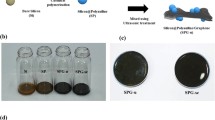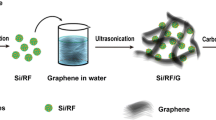Abstract
Large volume changes, poor conductivity, and unstable solid electrolyte interphase (SEI) are the main problems that hinder the development of Si electrodes. In this paper, we prepared graphene and citric acid as the carbon sources. Si@amorphous carbon/graphene (Si@C/G) composites were obtained by high-temperature calcination and self-assembly of electrostatic attraction. The electrostatic attraction of amino and carboxyl groups not only inhibited the agglomeration of Si particles and the accumulation of graphene sheets, but also helped encapsulate the carbon-coated nano-Si (Si@C) into graphene. Therefore, the volume expansion and collapse of Si were suppressed during charge and discharge. Meanwhile, graphene and amorphous carbon prevented Si from being directly exposed to the electrolyte. Furthermore, the three-dimensional (3D) conductive network composed of amorphous carbon and graphene improved the conductivity of Si-based electrodes. Compared with Si electrodes, Si@C/G electrodes showed good electrochemical performance.








Similar content being viewed by others
References
Scrosati B, Hassoun J, Sun YK (2011) Lithium-ion batteries. A look into the future. Energy Environ Sci 4(9):3287–3295
Marom R, Amalraj SF, Leifer N, Jacob D, Aurbach (2011) A review of advanced and practical lithium battery materials. Journal of Materials Chemistry 21(27):9938–9954
Xu ZL, Kim JK, Kang K (2018) Carbon nanomaterials for advanced lithium sulfur batteries. Nano Today 19:84–107
Wang J, Tang H, Zhang L, Ren H, Yu R, ** Q, ... Liu P (2016) Multi-shelled metal oxides prepared via an anion-adsorption mechanism for lithium-ion batteries . Nat Energy 1(5):16050
Wu H, Yu G, Pan L, Liu N, McDowell MT, Bao Z, Cui Y (1943) Stable Li-ion battery anodes by in-situ polymerization of conducting hydrogel to conformally coat silicon nanoparticles. Nat Commun 2013:4
Pan Q, Zuo P, Mu T, Du C, Cheng X, Ma Y, ... Yin G (2017) Improved electrochemical performance of micro-sized SiO-based composite anode by prelithiation of stabilized lithium metal powder. J Power Sour 347:170–177
Zong L, ** Y, Liu C, Zhu B, Hu X, Lu Z, Zhu J (2016) Precise perforation and scalable production of Si particles from low-grade sources for high-performance lithium ion battery anodes. Nano Lett 16(11):7210–7215
Zhang H, Li X, Guo H, Wang Z, Zhou Y (2016) Hollow Si/C composite as anode material for high performance lithium-ion battery. Powder Technol 299:178–184
Eom K, Lee JT, Oschatz M, Wu F, Kaskel S, Yushin G, Fuller TF (2017) A stable lithiated silicon–chalcogen battery via synergetic chemical coupling between silicon and selenium. Nat Commun 8:13888
Shelke MV, Gullapalli H, Kalaga K, Rodrigues MTF, Devarapalli RR, Vajtai R, Ajayan PM (2017) Facile synthesis of 3D anode assembly with Si nanoparticles sealed in highly pure few layer graphene deposited on porous current collector for long life Li-ion battery. Adv Mater Interfaces 4(10):1601043
Zhang YC, You Y, **n S, Yin YX, Zhang J, Wang P, ... Guo YG (2016) Rice husk-derived hierarchical silicon/nitrogen-doped carbon/carbon nanotube spheres as low-cost and high-capacity anodes for lithium-ion batteries. Nano Energy 25:120–127
Jangid MK, Sonia FJ, Kali R, Ananthoju B, Mukhopadhyay A (2017) Insights into the effects of multi-layered graphene as buffer/interlayer for a-Si during lithiation/delithiation. Carbon 111:602–616
Kim YM, Ahn J, Yu SH, Chung DY, Lee KJ, Lee JK, Sung YE (2015) Titanium silicide coated porous silicon nanospheres as anode materials for lithium ion batteries. Electrochim Acta 151:256–262
Wang T, Zhu J, Chen Y, Yang H, Qin Y, Li F, ... Lu B (2017) Large-scale production of silicon nanoparticles@ graphene embedded in nanotubes as ultra-robust battery anodes. J Mater Chem A 5(10):4809–4817
Shim HC, Kim I, Woo CS, Lee HJ, Hyun S (2017) Nanospherical solid electrolyte interface layer formation in binder-free carbon nanotube aerogel/Si nanohybrids to provide lithium-ion battery anodes with a long-cycle life and high capacity. Nanoscale 9(14):4713–4720
**e J, Tong L, Su L, Xu Y, Wang L, Wang Y (2017) Core-shell yolk-shell Si@ C@ Void@ C nanohybrids as advanced lithium ion battery anodes with good electronic conductivity and corrosion resistance. J Power Sources 342:529–536
Yue H, Wang S, Yang Z, Li Q, Lin S, He D (2015) Electrochim Acta 174:688–695
Wu P, Wang H, Tang Y, Zhou Y, Lu T (2014) ACS Appl Mater Interfaces 6:3546–3552
Zhou R, Fan R, Tian Z, Zhou Y, Guo H, Kou L et al (2016) J Alloys Compd 658:91–97
Li T, Li X, Wang Z, Guo H (2017) J Power Sources 342:495–503
Zhou X, Wu T, Hu B, Yang G, Han B (2010) Synthesis of graphene/polyaniline composite nanosheets mediated by polymerized ionic liquid. Chem Commun 46(21):3663–3665
Chen D, Tang L, Li J (2010) Graphene-based materials in electrochemistry. Chem Soc Rev 39(8):3157–3180
Zhu Y, Murali S, Stoller MD, Ganesh KJ, Cai W, Ferreira PJ, ... Su D (6037) Carbon-based supercapacitors produced by activation of graphene. Science 2011:332:1537
Lee JK, Smith KB, Hayner CM, Kung HH (2010) Silicon nanoparticles–graphene paper composites for Li ion battery anodes. Chem Commun 46(12):2025–2027
Zhao X, Hayner CM, Kung MC, Kung HH (2011) Flexible holey graphene paper electrodes with enhanced rate capability for energy storage applications. ACS Nano 5(11):8739–8749
**ang H, Zhang K, Ji G, Lee JY, Zou C, Chen X, Wu J (2011) Graphene/nanosized silicon composites for lithium battery anodes with improved cycling stability. Carbon 49(5):1787–1796
Chou SL, Wang JZ, Choucair M, Liu HK, Stride JA, Dou SX (2010) Enhanced reversible lithium storage in a nanosize silicon/graphene composite. Electrochem Commun 12(2):303–306
** Y, Zhang S, Zhu B, Tan Y, Hu X, Zong L, Zhu J (2015) Simultaneous purification and perforation of low-grade Si sources for lithium-ion battery anode. Nano Lett 15(11):7742–7747
** Y, Tan Y, Hu X, Zhu B, Zheng Q, Zhang Z, ... Zhu J (2017) Scalable production of the silicon–tin Yin-Yang hybrid structure with graphene coating for high performance lithium-ion battery anodes. ACS Appl Mater Interf 9(18):15388–15393
Zhou X, Yin YX, Wan LJ, Guo YG (2012) Self-assembled nanocomposite of silicon nanoparticles encapsulated in graphene through electrostatic attraction for lithium-ion batteries. Adv Energy Mater 2(9):1086–1090
Niu J, Zhang S, Niu Y, Song H, Chen X, Zhou J, Cao B (2015) Direct amination of Si nanoparticles for the preparation of Si@ultrathin SiOx@graphene nanosheets as high performance lithium-ion battery anodes. J Mater Chem A 3(39):19892–19900
Li R, Cao A, Zhang Y, Li G, Jiang F, Li S, ... Shu C (2014) Formation of nitrogen-doped mesoporous graphitic carbon with the help of melamine . ACS Appl Mater Interfaces 6(23):20574–20578
Mu T, Zuo P, Lou S, Pan Q, Li Q, Du C, ... Yin G (2018) A two-dimensional nitrogen-rich carbon/silicon composite as high performance anode material for lithium ion batteries. Chem Eng J 341:37–46
Chang J, Huang X, Zhou G, Cui S, Hallac PB, Jiang J, ... Chen J (2014) Multilayered Si nanoparticle/reduced graphene oxide hybrid as a high-performance lithium-ion battery anode. Adv Mater 26(5):758–764
Sun W, Hu R, Zhang H, Wang Y, Yang L, Liu J, Zhu M (2016) A long-life nano-silicon anode for lithium ion batteries: supporting of graphene nanosheets exfoliated from expanded graphite by plasma-assisted milling. Electrochim Acta 187:1–10
Chen H, Wang S, Liu X, Hou X, Chen F, Pan H, ... Zhou G (2018) Double-coated Si-based composite composed with carbon layer and graphene sheets with void spaces for lithium-ion batteries. Electrochim Acta 288:134–143
Huang YH, Bao Q, Duh JG, Chang CT (2016) Top-down dispersion meets bottom-up synthesis: merging ultranano silicon and graphene nanosheets for superior hybrid anodes for lithium-ion batteries. J Mater Chem A 4(25):9986–9997
Li Y, Yan K, Lee HW, Lu Z, Liu N, Cui Y (2016) Growth of conformal graphene cages on micrometre-sized silicon particles as stable battery anodes. Nat Energy 1(2):15029
Feng L, Han X, Su X, Pang B, Luo Y, Hu F, ... **a Y (2018) Metal-organic frameworks derived porous carbon coated SiO composite as superior anode material for lithium ion batteries. J Alloys Compds 765:512–519
Wang MS, Wang GL, Wang S, Zhang J, Wang J, Zhong W, ... Li X (2019) In situ catalytic growth 3D multi-layers graphene sheets coated nano-silicon anode for high performance lithium-ion batteries. Chem Eng J 356:895–903
Chen J, Mao Z, Zhang L, Tang Y, Wang D, Bie L, Fahlman BD (2018) Direct production of nitrogen-doped porous carbon from urea via magnesiothermic reduction. Carbon 130:41–47
Guo L, He H, Ren Y, Wang C, Li M (2018) Core-shell SiO@ F-doped C composites with interspaces and voids as anodes for high-performance lithium-ion batteries. Chem Eng J 335:32–40
Park CM, Choi W, Hwa Y, Kim JH, Jeong G, Sohn HJ (2010) Characterizations and electrochemical behaviors of disproportionated SiO and its composite for rechargeable Li-ion batteries. J Mater Chem 20(23):4854–4860
Wang K, Pei S, He Z, Huang LA, Zhu S, Guo J, ... Wang J (2019) Synthesis of a novel porous silicon microsphere@ carbon core-shell composite via in situ MOF coating for lithium ion battery anodes . Chem Eng J 356:272–281
Sun W, Wan L, Li X, Zhao X, Yan X (2016) Bean pod-like Si@ dopamine-derived amorphous carbon@ N-doped graphene nanosheet scrolls for high performance lithium storage. Journal of Materials Chemistry A 4(28):10948–10955
Yin YX, **n S, Wan LJ, Li CJ, Guo YG (2011) Electrospray synthesis of silicon/carbon nanoporous microspheres as improved anode materials for lithium-ion batteries. The journal of physical chemistry C 115(29):14148–14154
Kim JS, Nguyen CC, Kim HJ, Song SW (2014) Siloxane-capped amorphous nano-SiO x/graphite with improved dispersion ability and battery anode performance. RSC Adv 4(25):12878–12881
Yang Z, **a Y, Ji J, Qiu B, Zhang K, Liu Z (2016) Superior cycling performance of a sandwich structure Si/C anode for lithium ion batteries. RSC Adv 6(15):12107–12113
Lin J, He J, Chen Y, Li Q, Yu B, Xu C, Zhang W (2016) Pomegranate-like silicon/nitrogen-doped graphene microspheres as superior-capacity anode for lithium-ion batteries. Electrochim Acta 215:667–673
Li X, Tian X, Yang T, Wang W, Song Y, Guo Q, Liu Z (2018) Silylated functionalized silicon-based composite as anode with excellent cyclic performance for lithium-ion battery. J Power Sources 385:84–90
Funding
This study was supported by Jiangxi scientific fund (20142BBE50071) and Jiangxi education fund (KJLD13006).
Author information
Authors and Affiliations
Corresponding author
Ethics declarations
Conflict of interest
The authors declare no competing interests.
Additional information
Publisher's Note
Springer Nature remains neutral with regard to jurisdictional claims in published maps and institutional affiliations.
Rights and permissions
About this article
Cite this article
Liu, P., Sun, X., Xu, Y. et al. By self-assembly of electrostatic attraction to encapsulate protective carbon-coated nano-Si into graphene for lithium-ion batteries. Ionics 28, 1099–1108 (2022). https://doi.org/10.1007/s11581-021-04247-y
Received:
Revised:
Accepted:
Published:
Issue Date:
DOI: https://doi.org/10.1007/s11581-021-04247-y




